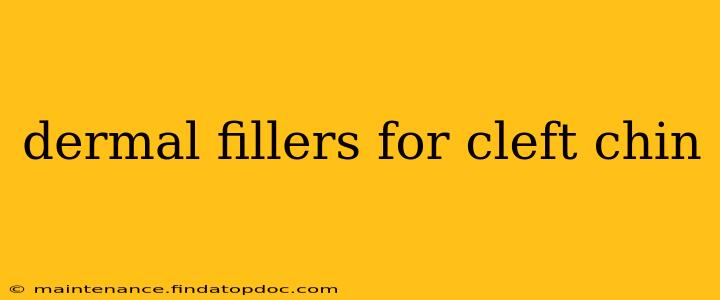A cleft chin, also known as a chin dimple or a chin cleft, is a naturally occurring indentation in the chin. While some people embrace this feature, others may wish to minimize or eliminate it. Dermal fillers offer a non-surgical solution to reshape the chin and soften the appearance of a cleft chin. This guide explores the use of dermal fillers for cleft chin correction, addressing common questions and concerns.
What are Dermal Fillers?
Dermal fillers are injectable substances used to add volume and fullness to different areas of the face, including the chin. They consist of various materials, such as hyaluronic acid (the most common type), collagen, or calcium hydroxylapatite. These fillers are designed to be biocompatible, meaning they integrate well with the body's tissues. The effect of dermal fillers is temporary, lasting anywhere from several months to a year or more, depending on the type of filler used and individual factors.
How are Dermal Fillers Used to Correct a Cleft Chin?
The procedure involves carefully injecting the filler into the chin area to gradually fill in the cleft and create a smoother, more uniform chin profile. The goal isn't necessarily to completely eliminate the cleft but to soften its appearance and create a more aesthetically pleasing contour. A skilled injector will strategically place the filler to subtly reshape the chin, ensuring natural-looking results.
What are the Different Types of Fillers Used for Cleft Chin Correction?
Several types of dermal fillers can be used, and the best choice depends on factors like the depth of the cleft, desired results, and individual skin characteristics. Your dermatologist or plastic surgeon will help you determine the most appropriate filler for your needs. Common options include:
- Hyaluronic Acid Fillers: These are popular due to their biocompatibility, ease of injection, and reversibility (they can be dissolved if necessary). Examples include Juvéderm and Restylane.
- Calcium Hydroxylapatite Fillers: These provide longer-lasting results than hyaluronic acid fillers.
- Poly-L-lactic acid fillers: These stimulate collagen production, leading to more gradual and long-lasting results.
How Long Do the Results Last?
The duration of results varies depending on the type of filler used and individual factors like metabolism and lifestyle. Hyaluronic acid fillers generally last for several months, while other types may provide results for a year or longer. Maintenance injections may be needed to sustain the desired results.
Are There Any Side Effects?
As with any injection procedure, there are potential side effects, though they are usually mild and temporary. These can include:
- Bruising and swelling: This is common and typically resolves within a few days.
- Redness and tenderness: This is also common and resolves quickly.
- Lumps or bumps: These are rare but can be addressed by your injector.
- Infection: This is uncommon with proper sterile techniques.
It's crucial to choose a qualified and experienced injector to minimize the risk of complications.
What is the Recovery Time?
Recovery is generally quick and straightforward. Most individuals can return to their normal activities immediately after the procedure. Some mild swelling and bruising may be present for a few days, but this typically subsides quickly.
How Much Does It Cost?
The cost of dermal filler treatment for a cleft chin varies depending on factors like the amount of filler needed, the type of filler used, and the injector's fees. It's essential to discuss pricing with your chosen provider during a consultation.
What Should I Expect During a Consultation?
During a consultation, your injector will assess your chin, discuss your goals, and recommend the most suitable filler and treatment plan. They will also explain the procedure, potential risks and benefits, and answer any questions you may have. Be sure to have realistic expectations and openly communicate your concerns.
Is This Treatment Right for Me?
Dermal fillers for a cleft chin are a good option for those who desire a non-surgical way to improve the appearance of their chin. However, it's crucial to have realistic expectations and understand that the results are temporary. The best way to determine if this treatment is right for you is to consult with a board-certified dermatologist or plastic surgeon. They can assess your individual needs and determine the best course of action.
